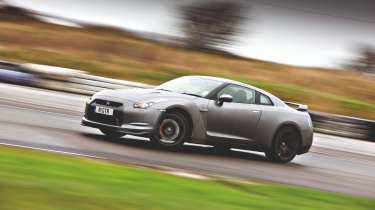Nissan GT-R (R35, 2009 - 2022) review – the Porsche 911 Turbo’s greatest rival
The R35 Nissan GT-R purveys a legendary status like few others. Bespoke, highly strung and intense, the R35 will live on as a high point in Japanese automotive engineering
Back in 2007 when the R35 Nissan GT-R first debuted in Japan, its facts and figures looked like something from a dreamscape – an ensemble of tech none doubted took the full seven years of development for Nissan to realise from approval to debut.
Its hardware tally was shocking (bespoke twin-turbocharged V6 engine, transaxle dual-clutch transmission, an active all-wheel-drive system that required two prop shafts and active differentials on both axles for total torque vectoring) – it seemed like Nissan might have gone too far, creating something synthetic and overly augmented.
It was a narrative that many claimed when it arrived in Europe in 2009 – a digitised supercar slayer for the PlayStation generation. The reality couldn’t have been more different. Yes, it was big, heavy and very clever but its myriad systems and titanic powertrain coalesced into a properly involved driving experience.
Immersive in the extreme and capable beyond what the figures suggested, it was anything but the anodised, characterless device that some found it all too easy to label. The fact it elbowed aside the Lamborghini Gallardo LP560-4, the Porsche 997 GT2 and Renault Sport Mégane R26.R for eCoty supremacy in 2008 says it all, really.
The GT-R served for many years, picking up numerous upgrades along the way, as is the Japanese way, as you’d hope for a car that would see opposition from no less than three generations of Porsche 911 Turbo. Changes were made for almost every one of its 13 model years, from tiny spec changes, to special editions, to wholesale facelifts. It’s difficult to count them all but we’ll summarise the main moments of change as best we can.
More reviews
Group tests
In-depth reviews
Reviews
- 2025 Nissan GT‑R Nismo Final Edition - Japan's 911 GT3 RS still has it
- Nissan GT-R Nismo (R35, 2014 - 2025) review – Godzilla on steroids is a Japanese icon
- 2017 Nissan GT-R review
- Nissan Skyline GT-R R32 - review, history, prices and specs
- Nissan GT-R review - The GT-R has never been more usable, yet it's still blisteringly fast
In 2009 the GT-R got a small boost in power up to 478bhp. In 2011, it was lightly facelifted with LED dayrunning lights, a revised front apron and new light clusters, with a boost to 523bhp and added chassis focus under the skin. Then in 2012, it got even more potent, with a jump to 542bhp, while the suspension was revised again.
These performance bumps came from incremental adjustments to the exhaust, inlet, cooling, timing, fueling and more. For 2014, the R35 GT-R was fettled again but while no more power was on the menu, new front and rear lights modernised the GT-R’s look for its sixth year on sale.
In 2017 Nissan gave the R35 GT-R the biggest facelift since its launch, visually inside and out and under the skin. Redesigned front and rear facias improved airflow over the car as well as key component cooling, while the chassis structure was stiffened by five per cent.
Under the bonnet, the boost pressure was dialled up, for a relatively mild boost to 562bhp, at a headier 6800rpm. All GT-Rs up to this point peaked at 6400rpm. Max revs were also increased, from 7000 to 7100rpm. The 2017 GT-R was a more refined, upmarket GT-R, with revisions to the transmission aimed at smoothness, better materials and a more upmarket design inside and reduced NVH. This was a heavier GT-R as a consequence, too. While the GT-R received new, more efficient, turbochargers in 2019, not much else changed until another significant visual facelift in 2024 – a version of the GT-R never meant for Europe.
Special versions of the GT-R were coming out of the gates almost from day one. The SpecV was our first taste of a more extreme track-focused GT-R, that was lighter, with a more aggressive exhaust and racier Rays wheels. Subsequent Track Edition models joined the main lineup and followed a similar formula, offering a stiffer, more focused flavour of GT-R but still sitting under the full-on GT-R Nismo flagship that first arrived in 2014. In the end, over 40,000 Nissan GT-Rs were built and sold over the course of a near 18-year run on sale. A product of its time, any unlikely successor is sure to feature some form of electrification. The R35 GT-R was novel on arrival and surely, its like won’t be repeated.
Nissan GT-R: in detail
- Engine, gearbox and technical highlights – Starting at 478bhp in 2007, rising to 562bhp in 2017. Rapid dual-clutch auto was also continuously revised and is smoother in 2017+ cars.
- Performance and 0-60mph time – Always a blisteringly fast car, the GT-R only got faster throughout its life. The Nismo versions were even faster still.
- Ride and handling – Even after all these years, the GT-R endures as one of the most capable cross-country machines there’s ever been, the experience nipped, tucked and finely honed over the course of its first decade.
- MPG and running costs – Be in no doubt, any GT-R will be expensive to run. Not just on fuel but also insurance, and it'll need more maintenance than the average Nissan too.
- Interior and tech – Rough and ready to begin with but improvements made in 2017 bestowed a certain quality on the GT-R's cabin that was absent before.
- Design – The GT-R is best described as big and bold. Its looks aren't to everyone's tastes, but it has real presence on the road. There’s nothing else like it.
What we said
‘The first couple of proper corners reveal that the seemingly minor chassis upgrades have had quite a profound effect. The first thing of note is that the steering is more positive; there’s no hesitation, no taking up of inertia-laden slack, you simply turn the wheel and the nose darts for the apex. Then you thread the car through a quickfire direction change, left into right over alternate cambers and, although you’re pushing on, the car changes tack quickly and cleanly.
‘The revised front suspension geometry, adjusted rear roll- centre and the new tyres have dramatically affected the feel and nature of the GT-R’s dynamics. It feels like all the slack has been taken out and the mass of the car is held in tight check – it no longer feels as heavy or bulky. It’s reassuringly planted and more responsive, and this makes it a simpler, purer experience. You lean on the front into turns and pick up the throttle as soon as you dare, and if you’re really keen the back end might edge a fraction wide on the exit, which a small twist of steering corrects.
‘The current Nordschleife lap time for the GT-R is 7min 26sec (which is astonishing) and the teasing data-sheet we were shown suggested the MY11 GT-R would still be in the twenties. I think that’s too conservative. The combination of much better turn-in and terrific roll and pitch control, plus the extra power, must surely get the GT-R into the teens. There’s a real sense of dynamic finesse about the GT-R now, a feeling that the clever systems are more at work in the background and pure driver interaction has come to the fore.’ – John Barker, evo 150, December 2010.
‘Perhaps the clearest indication of how this GT-R has subtly shifted its character is that on a bumpy, twisting piece of Belgian B-road, I find myself using the R setting for the Bilstein DampTronic suspension to keep everything tied down and free from float. In previous iterations of the R35, the R mode was the preserve of silky smooth, freshly laid circuits, and in some cases Comfort mode was all you needed for quick road driving. The increased calmness is actually a bonus through the high-speed corners of Spa-Francorchamps.
‘The familiar balance of the ATTESA E-TS four-wheel-drive system is still there, and with trail braking it is more obvious than on the road, but it’s definitely not as aggressive as before. This makes the car calmer mid- corner but also a little less instantly adjustable than some previous GT-Rs. If you think it sounds like there is now a bit more of the ‘GT’ and a little less of the ‘R’ in this version of the GT-R, you’re right.
‘This is the standard GT-R, which can be purchased in several different trim levels. Then there’s the Track Edition with enhanced body rigidity, 20-inch Rays alloys, uprated suspension and a carbon rear spoiler. At the top of the tree, the Nismo GT-R. This clear three-pronged attack is a reflection of how the R35 has been developed and tweaked in recent years, teasing out and magnifying various facets of the original. In some ways it makes sense to allow customers to choose the type of GT-R they want, but there is a slight feeling that the Swiss Army knife has been split up into a rack of individual tools.’ – Henry Catchpole, evo 224, August 2016.
Nissan GT-R (325, 2009 - 2022) specs
| Nissan GT-R (07-10) | Nissan GT-R (10-12) | Nissan GT-R (12-16) | Nissan GT-R (17+) | |
|---|---|---|---|---|
| Engine | V6, 3799cc twin turbo | V6, 3799cc twin turbo | V6, 3799cc twin turbo | V6, 3799cc twin turbo |
| Max power | 478bhp @ 6400rpm | 523bhp @ 6400rpm | 542bhp @ 6400rpm | 562bhp @ 6800rpm |
| Max torque | 433lb ft @ 3200rpm-5200rpm | 448lb ft @ 3200-5800rpm | 466lb ft @ 3200-5800rpm | 467lb ft @ 3300-5800rpm |
| Transmission | Six-speed DCT, ATTESA ET-S four-wheel drive, rear LSD, VDC-R | Six-speed DCT, ATTESA ET-S four-wheel drive, rear LSD, VDC-R | Six-speed DCT, ATTESA ET-S four-wheel drive, rear LSD, VDC-R | Six-speed DCT, ATTESA ET-S four-wheel drive, rear LSD, VDC-R |
| Weight (kerb) | 1740kg (279bhp/ton) | 1735kg (301bhp/ton) | 1740kg (311bhp/ton) | 1785kg (314bhp/ton) |
| 0-62mph | 3.5sec | 2.7sec | 2.7sec | 2.7sec |
| Top speed | 197mph | 197mph | 199mph | 201mph |
| Price new | £56,795 | £70k+ | £75k+ | £80k+ |
| Price now | From £30k | From £30k | From £40k | From £60k |
What to pay and buying guide
The return of Godzilla after a seven-year absence proved to be well worth the wait when the new Nissan GT-R landed on UK shores in 2009. The technological tour de force that was the R35 GT-R comfortably became the performance yardstick in the alluringly accessible £50k price bracket.
Shortly after the GT-R’s UK release, the price began to creep up in £10k increments after each iteration emerged from the factory. Bargain status didn't totally abandon the GT-R, even as prices rose beyond £85,000, up to over £100,000 for the more focused Track Edition. Because as ever, it was bothering sports and supercars that were tens of thousands more.
The £150k-plus Nismo sat atop the GT-R throne, its driver tied into a carbon-backed Nismo seat. From there you can wind-out the uprated V6 that produces more power and torque from behind the carbon fibre apron – one of many external parts recast in the lightweight composite.
The GT-R’s truest rival throughout its life, also sporting sophisticated all-wheel drive and turbocharged six-cylinder power, was the Porsche 911 Turbo, first with the 997 and 991 and towards the end, the first phase of the 992. The Nismo GT-R was more of a rival to Porsche’s 911 GT3 RS and the Mercedes-AMG GT R, and especially in its post MY19 update became one of the most intoxicatingly brilliant driver’s cars with a superb level of fluidity on the road and an otherworldly sense of poise and composure.
The GT-R as we know it came to the end of its life in Europe at the end of 2021, with the base, Track Edition and Nismo models all calling it a day at the same time. In other global markets the model lived on intermittently, even getting a facelift in 2024 in Japan but as of early 2025, its time is all but up.
Spanning such a long term of service, with so many upgrades over the years, the range of prices for GT-Rs is predictably wide. The earliest, baggiest, leggiest examples are closing in on £30,000 – these will require a bit of bravery, given the known issues with the drivetrain and even rust that they can have. Later model years with lower miles have held better, to the point that some 2017 and 2018 cars are still in the £70-£80k range.
Needless to say, many GT-Rs have been modified, with Litchfield the most popular and respected tuner and fettler. With any GT-R, but especially a modified, higher-powered example, make sure there’s bombproof service and MOT history, with documentation to back it up.
As above, these aren’t trouble-free cars and can incur some hefty bills. The common bell housing rattle comes from a faulty bearing at the end of the flywheel shaft, while there can also be driveline issues from the clutches all the way to the diffs and more. A wise buyer will seek out cars that have had common niggles addressed recently.









